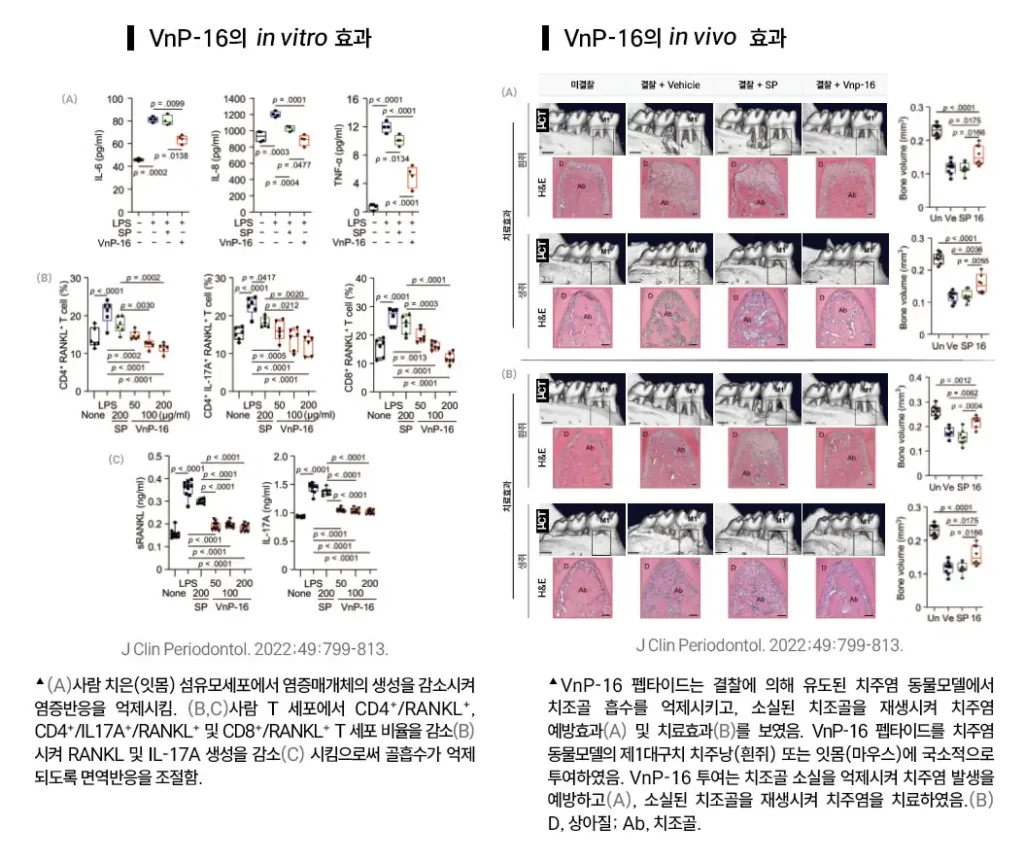Introduction
Periodontitis Therapeutic
VnP-16 peptide promotes the migration of periodontal ligament cells and their differentiation into osteoblasts. It also suppresses inflammatory responses in gingival fibroblasts and regulates host immune responses by reducing the production of RANKL and interleukin-17A in T lymphocytes, thereby inhibiting osteoclast differentiation and bone resorption.
| What is VnP-16?
– A 12-mer low molecular weight peptide derived from human vitronectin, which does not elicit immune rejection when administered to the human body.
– Suppresses inflammatory responses in human gingival fibroblasts and modulates immune responses in human T cells.
– A novel therapeutic agent for the treatment and prevention of periodontitis, which promotes alveolar bone formation while simultaneously inhibiting bone resorption in periodontitis models.
| Key Differentiators from Conventional Therapies
*Conventional periodontal treatments such as scaling, root planing, and curettage focus primarily on removing inflammation or slowing the progression of alveolar bone loss. However, they are limited in their ability to regenerate already damaged or lost alveolar bone.
| VnP-16 Peptide
VnP-16 peptide suppresses inflammatory responses in gingival fibroblasts and modulates immune activity in T cells. By selectively regulating the differentiation of osteoblasts and osteoclasts, it promotes alveolar bone formation while inhibiting bone resorption. In doing so, VnP-16 not only regenerates alveolar bone lost due to periodontal disease, but also prevents further bone loss—making it a novel therapeutic agent for both treatment and prevention of periodontitis.

J Clin Periodontol.
2022;49:799-813.
▶ (A) In human gingival fibroblasts, VnP-16 reduces the production of inflammatory mediators, thereby suppressing inflammatory responses.
(B, C) In human T cells, it decreases the proportion of CD4⁺/RANKL⁺, CD4⁺/IL-17A⁺/RANKL⁺, and CD8⁺/RANKL⁺ T cells (B), leading to reduced secretion of RANKL and IL-17A (C). This immunomodulatory effect ultimately contributes to the inhibition of bone resorption.
J Clin Periodontol.
2022;49:799-813.
▶ VnP-16 peptide demonstrated both preventive (A) and therapeutic (B) effects in a ligature-induced periodontitis animal model by inhibiting alveolar bone loss and promoting regeneration of lost bone.
The peptide was topically administered into the periodontal pocket of the first molar in rats or onto the gingiva in mice.
Local application of VnP-16 effectively suppressed alveolar bone resorption (A) and stimulated alveolar bone regeneration (B), thereby preventing the onset and enabling the treatment of periodontitis.
(D: dentin; Ab: alveolar bone)
Osteoporosis Therapeutic
VnP-16 is a 12-mer functional peptide derived from human vitronectin. It promotes osteoblast differentiation without triggering immune rejection and inhibits the bone-resorbing activity of osteoclasts, effectively restoring bone mass lost due to osteoporosis.
| What is VnP-16 as a Periodontitis Treatment?
iONEBIO Inc aims to shift the paradigm of dental diagnostics toward prevention by providing effective diagnostic solutions for both patients and dental professionals—utilizing salivary-based immunological testing technologies.
Oral Rapid Test No.4 is a multi-analyte POCT (Point-of-Care Testing) kit, designed for convenient use by both dental clinics and patients.
Key biomarkers:
Pg (Porphyromonas gingivalis): High-risk oral pathogen
MMP-8 (Matrix Metalloproteinase-8): Collagen-degrading enzyme
S.P (Salivary Proteins): Protective factors against oral pathogens
pH (Salivary pH): Indicator of oral acidity and resistance
| Key Differentiators of VnP-16
* Bisphosphonates, the most widely used class of osteoporosis drugs, help prevent further bone loss but are unable to reverse existing bone degradation. Additionally, they are associated with significant side effects, including osteonecrosis of the jaw.
* Prolia® (denosumab), a RANKL inhibitor, has a high production cost and does not stimulate new bone formation. While it delays bone resorption, it has also been linked to severe side effects such as jawbone necrosis.
| VnP-16 Peptide
VnP-16 treats osteoporosis by simultaneously promoting bone formation and inhibiting bone resorption, effectively restoring reduced bone mass.
Unlike existing treatments, it has no reported side effects such as jawbone necrosis, and offers a cost-effective manufacturing advantage.

J Clin Periodontol.
2022;49:799-813.
▶ (A) VnP-16 suppresses inflammatory responses by reducing the production of inflammatory mediators in human gingival fibroblasts.
(B, C) In human T cells, it decreases the proportions of CD4⁺/RANKL⁺, CD4⁺/IL-17A⁺/RANKL⁺, and CD8⁺/RANKL⁺ subtypes (B), thereby reducing the secretion of RANKL and IL-17A (C).
This immunomodulatory effect ultimately contributes to the inhibition of bone resorption.


